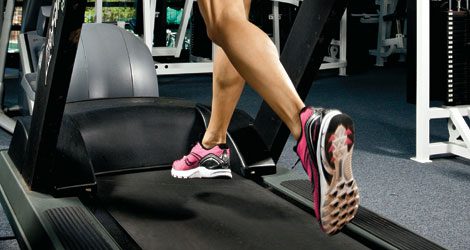Coach Michael Liberzon: Head indoors for quality running this winter

December 16, 2016: -9C, 35kph winds, snow squall. This is right now. I am not exaggerating.
I will be running home from my cycling and weight training studio tonight, but I will be taking it easy. I actually really enjoy easy runs in the snow. They’re fun, challenging, and the scenery is hard to beat. So while I am looking forward to my upcoming commute, performing any kind of run speedwork in this weather is the opposite of fun. The unsteady, slippery footing makes running fast much more difficult and dangerous too! Plus the gold standard metric for intensity while running – pace – is no longer useful in this role when each footfall is a literal balancing act.
So when the snow starts to fly, I ask my athletes to head indoors for all of their run interval training. Treadmills are easy enough to find for this. Hate treadmills? Look for an indoor track instead. Both are great options for high quality, intense run training during the winter.
Cody Beals wrote a terrific article on the physics of treadmill work. It’s a great read for anyone still unconvinced about the efficacy of treadmills and their utility in run training. He does a better job than I could in making the case for treadmills and talking about best practices, so I will leave it at that.
Indoor tracks are awesome for those who need to move through space to feel that sense of accomplishment. Look for soft running surfaces and as long a track as you can find. Tight, short course tracks mean a great deal of turning – especially during longer runs. This causes uneven muscular loading and is not ideal. My personal favourite is the Monarch Park track in east Toronto. At 372m and with a high-end, rubberized surface it ticks my boxes for a great indoor track.
Now for all of your data junkies – or the ones coached by data junkies – running indoors poses an important problem: how do you accurately track pace when you are on a belt or have no GPS indoors? Treadmills will give you speed or pace – usually in miles – but they are notoriously unreliable. Indoor tracks will often have distance markers, but you’ll need a good head for numbers to keep all of your splits straight.
Enter the footpod!
This timing chip-sized sensor is a great addition to your data collection arsenal. Once calibrated, your footpod will provide remarkably accurate pace and distance data. I consider owning one extremely desirable – if not an absolute must.
Calibrating the current generation of footpods is remarkably simple. All you do is run outdoors with the footpod on your shoe and connected to your GPS watch. The GPS too must be enabled. Your watch then uses distance data from the satellite signal to automatically calibrate the information it receives from the footpod. Presto! You don’t need to enable calibration in any way. Your watch will automatically attempt to calibrate / re-calibrate your footpod each time it’s connected and you have a GPS signal.
I find that just one 10k run is sufficient for accurate calibration. There is only one caveat: you must have good satellite reception during the process, so avoid tall buildings, underpasses, tunnels, and heavy tree cover.
Two final notes on footpods.
- In order to get good quality data, your footpod must be well secured. So make sure that it’s snug and does not bounce around.
- If you change footwear, do your best to place the footpod on the same spot and on the same – right or left – shoe. Better still, do another outdoor calibration run before you head indoors.
Happy (indoor) training!
Michael is an NCCP trained triathlon coach, certified personal trainer, and kettlebell instructor. His degree in mechanical engineering supports his evidence-based approach to coaching.
Michael is also the owner and head coach of the X3 Training Lab in Toronto.
